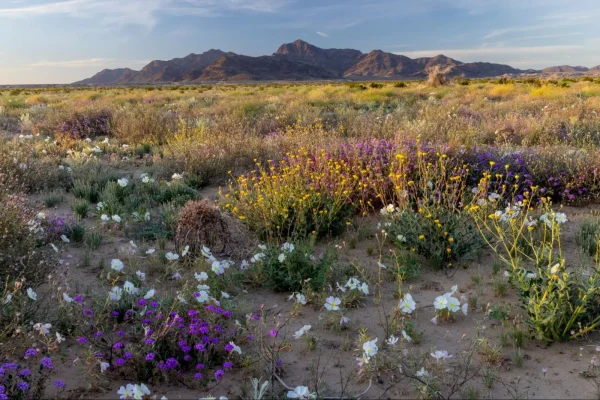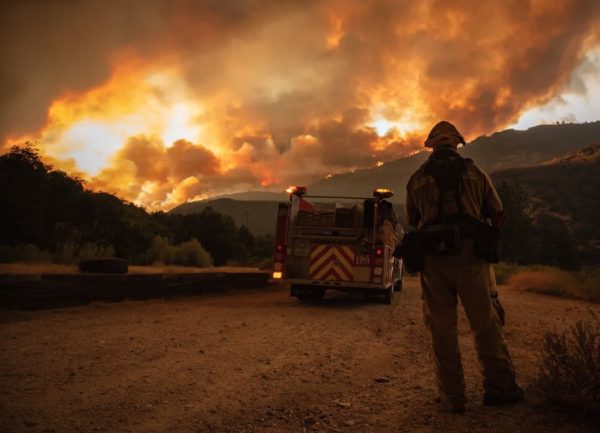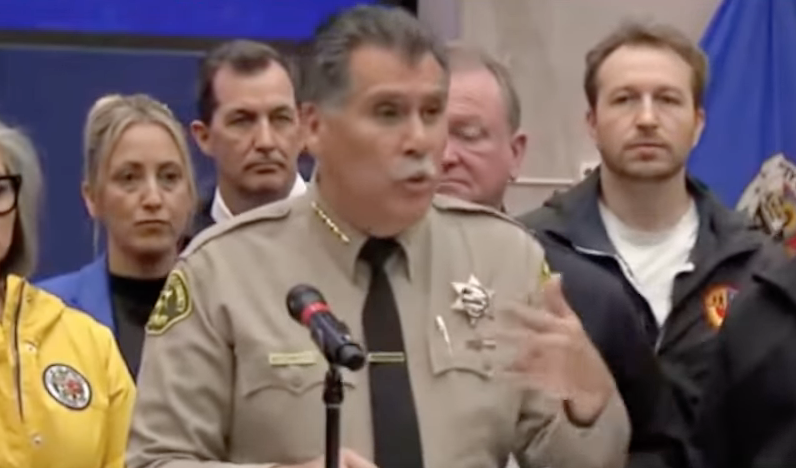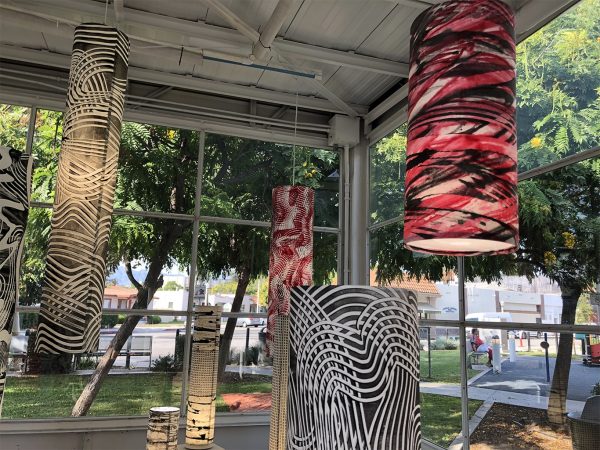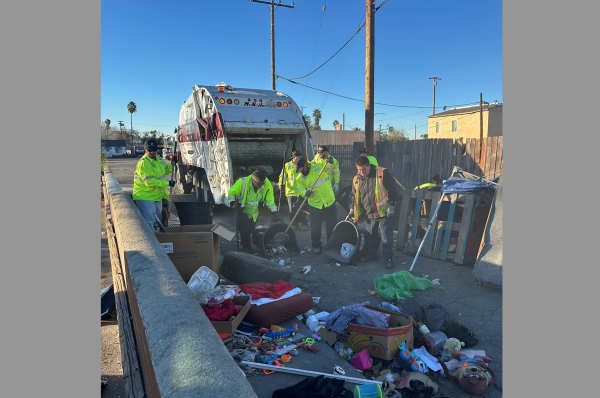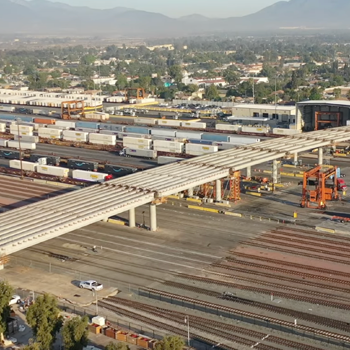A historically fierce windstorm Tuesday in Southern California that has caused destructive wildfires prompted President Joe Biden to cancel a trip from Los Angeles to the Coachella Valley, where he was to announce two national monuments in the state, including Chuckwalla in Riverside County.
The president and first lady Jill Biden arrived at LA International Airport aboard Air Force One on Monday morning from New Orleans, where they met with families and community members affected by the New Year’s Day terror attack on Bourbon Street that left 15 people dead and dozens injured, according to the White House.
Biden had been scheduled to travel to Thermal in Riverside County early Tuesday afternoon to officially announce the Chuckwalla National Monument near just south of Joshua Tree National Park and also the Sáttítla National Monument in Northern California. The two monuments will protect 848,000 acres of land that are of “scientific, cultural, ecological and historical importance,” according to the White House.
After considering having Biden make the monument announcement from the LA area, White House officials said later that the event would take place next week “so that key stakeholders can attend.” Details of the rescheduled event were not immediately available.
Instead, Biden remained at his hotel in the Santa Monica/West LA area, where he received briefings on the Palisades Fire and other active wildfires in the region.
According to the White House, the president and first lady left their hotel Wednesday morning to travel to Cedars-Sinai Medical Center, where his 31-year-old granddaughter Naomi gave birth to a daughter via Cesarean section. The Bidens arrived at the hospital at about 10:15 a.m. Wednesday and spent roughly 40 minutes there.
Biden’s son Hunter, Naomi’s father, arrived at the hospital with his wife Melissa and son Beau. Biden said later Naomi had given birth to a 10-pound baby girl, his first great-grandchild. He has seven grandchildren.
The Bidens left the hospital shortly before 11 a.m. Wednesday en route to Santa Monica Fire Station 5 near Santa Monica Airport to receive the wildfire briefing.
“We’re doing anything and everything and as long as it takes to contain these fires … to make sure you get back to normal,” Biden said after hearing from local officials. “It’s going to be a hell of a long way. It’s going to take time.”
The Bidens then flew via helicopter from Santa Monica Airport to Los Angeles International Airport, where they boarded Air Force One for a flight back to Washington, D.C.
It was unclear if Biden would return to the Southland next week for the national monument announcement.
The Chuckwalla National Monument will preserve more than 624,000 acres of public land and is Biden’s “capstone action to create the largest corridor of protected lands in the continental United States, covering nearly 18 million acres stretching approximately 600 miles,” according to the White House. “This new Moab to Mojave Conservation Corridor protects wildlife habitat and a wide range of natural and cultural resources along the Colorado River, across the Colorado Plateau, and into the deserts of California. It is a vitally important cultural and spiritual landscape that has been inhabited and traveled by Tribal Nations and Indigenous peoples since time immemorial.”
Biden was also set to officially announce Tuesday the Sáttítla Highlands National Monument in Northern California, which will encompass more than 224,000 acres of varied habitat that includes areas of the Modoc, Shasta-Trinity and Klamath national forests.
The Moab to Mojave Conservation Corridor stretches from Bears Ears National Monument and Grand Staircase-Escalante National Monument in southwestern Utah, to which Biden restored protections in 2021, through Baaj Nwaavjo I’tah Kukveni — Ancestral Footprints of the Grand Canyon National Monument in Arizona and Avi Kwa Ame National Monument in Nevada, which received federal protection in 2023, officials said. The corridor reaches the deserts and mountains of Southern California with the designation of the Chuckwalla National Monument.
Gov. Gavin Newsom, who was scheduled to attend Biden’s event in Riverside County said in a statement Tuesday, “California is now home to two new national monuments that honor the tribes that have stewarded these lands since time immemorial. Thanks to President Biden and the leadership of California tribes and local communities, we’re protecting 840,000 acres of some of our state’s most culturally significant lands. This is a huge boost for our efforts to protect 30% of California’s lands and coastal waters.”
The monument designation outlaws energy-related drilling or mining and protects the ancestral homelands and cultural landscapes of the Cahuilla, Chemehuevi, Mojave, Quechan and Serrano nations and other Indigenous peoples, according to the White House. The new monument has five distinct areas that encompass sacred sites, ancient trails, historic properties, cultural areas, religious sites, petroglyphs, geoglyphs and pictographs.
Tribal nations and Indigenous peoples in the region lived and traveled through the areas now protected by the monument. One such location is the southern edge of a travel route that stretched north and east through what are now the Avi Kwa Ame and Baaj Nwaavjo I’tah Kukveni, known as the Ancestral Footprints of the Grand Canyon National Monuments.
Leaders from Southern California tribes went to the nation’s capital last year to advocate for protecting the homelands of local Indigenous cultures.
“Since time immemorial, we have called the lands in the proposed Chuckwalla National Monument home,” Secretary Altrena Santillanes of the Torres Martinez Desert Cahuilla Indians said in an August statement. “These lands contain thousands of cultural places and objects of vital importance to the history and identity of the Torres Martinez Desert Cahuilla Indians.”
Interior Department Secretary Deb Haaland said in a statement Tuesday, “The stunning canyons and winding paths of the Chuckwalla National Monument represent a true unmatched beauty. It was my honor to visit this area to explore and meet with federal, state, Tribal and local leaders to hear about the need to protect and conserve this sacred area. President Biden’s action today will protect important spiritual and cultural values tied to the land and wildlife. I am so grateful that future generations will have the opportunity to experience what makes this area so unique.”
The Chuckwalla National Monument is just south of Joshua Tree National Park in southeastern Riverside County and is located at the confluence of the Mojave and Colorado deserts.
The area’s natural features include “mountain ranges, canyons and washes, dramatic rock formations, palm oases and desert-wash woodlands.
“Its natural wonders include the Painted Canyon of Mecca Hills, where visitors can wind through towering rock walls and marvel at the landscape’s dramatic geologic history, and Alligator Rock, a ridge that has served as a milestone for travelers for millennia,” according tot the White House. “The region is also home to more than 50 rare species of plants and animals, including the desert bighorn sheep, Agassiz’s desert tortoise, and the iconic Chuckwalla lizard, from which the monument gets its name.”
Officials said the monument will improve wildlife’s access habitats and safeguard clean water for over 40 million people via protections for the Colorado River region. The monument will also offer outdoor recreation opportunities for historically underserved communities in the Coachella Valley.
Officials also noted the monument’s synergy with clean energy.
“The monument upholds the balance of natural and cultural resource protection and renewable energy development that a wide range of stakeholders forged for the region through the Department of the Interior’s 2016 Desert Renewable Energy Conservation Plan,” according to the White House. “The new national monument will allow the construction and expansion of electric transmission and distribution within the monument to transport clean energy to western cities. Additionally, the designation is consistent with the continued development of renewable energy projects sited in the DRECP’s Development Focus Areas, many of which are near or adjacent to the monument.”
In 2024 at least 24 members of Congress from California, including Rep. Raul Ruiz, D-Indio, and U.S. Sens. Alex Padilla and Laphonza Butler, called for a Presidential Proclamation under the 1906 Antiquities Act to officially establish the national monument.
The Chuckwalla monument also drew support from a number of tribal leaders and representatives, at least eight city councils in the Coachella Valley and more than 225 area businesses and organizations.
“For the Quechan people, a national monument designation status for the land means preserving the lifeways, culture, stories and teachings that connect us to our past, present and future,” Donald Medart Jr. of the Fort Yuma Quechan Indian Tribe Council said in a statement.
More information about the campaign to establish the Chuckwalla National Monument is available via protectchuckwalla.org.
Updated Jan. 9, 2025, 12:19 p.m.

